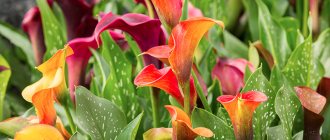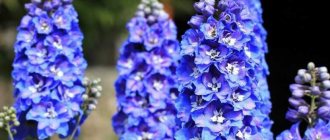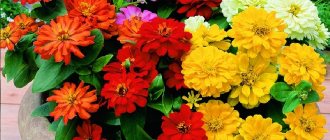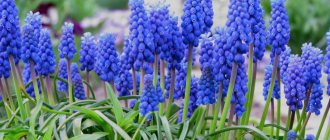Low-growing flowers for flower beds will be a wonderful decoration for any area.
Florists highlight a variety of solutions and combinations made from annual or perennial plants.
There are many shades that harmonize perfectly with each other. Using a creative approach, you can create exquisite compositions and ornaments that will serve as a wonderful decoration for courtyard areas.
Flowerbed of low-growing flowers
On their own, such flowers are small in height, usually no more than thirty centimeters. Experts identify several options for using beautiful plants:
- Creating a flower bed using several types of low-growing flowers.
- Design of a composition consisting of several tiers.
- Border fencing, when flowers create a bright border.
Border of low-growing flowers
- Use as a covering for lawns located on private or urban areas.
- Beautiful division of the yard into several sections.
- Create an exquisite design using colorful plants.
Ornament of low-growing flowers
Depending on the task at hand, you need to choose flowers that suit your taste. With the help of bright plantings, you can create unique compositions that serve as decoration for the area.
How to make a flower arrangement correctly?
Do you want to give your yard a finished look? It makes sense to contact a professional florist who will help you create a project designed specifically for your case.
Project of a flower bed of low-growing flowers
A professional worker will come to your site and perform the following operations:
- Will appreciate the overall design created on the territory.
- He will take measurements of the area where you want to plant a flower bed.
- He will draw up a project for the proposed flowerbed so that you can evaluate the attractiveness of the proposed option.
- Select types of low-growing flowers for flower beds intended for planting.
Low-growing flowers for flower beds
The help of a specialist will allow you to get the most attractive solution. You can create a special atmosphere in your area; a bright composition will always please the eye and create a wonderful mood.
Creating a flower bed on a summer cottage
Are you used to spending the summer at the dacha? Naturally, you want to surround yourself with beautiful things and objects. In addition to garden furniture, you need to pay attention to plants designed to create a wonderful mood.
One of the modern options is a flower bed made up of low-growing flowers. You can choose annual or perennial plants. Available in a variety of colors that can be perfectly combined with each other.
Flowerbed of perennial low-growing flowers
The following compositions are used for the summer cottage:
- A flowerbed with a strict geometric shape.
Round flowerbed of low-growing flowers
- A flowerbed composed of both large and low-growing flowers.
Combined flower bed of tall and low flowers
- Flowerbeds of arbitrary shape.
A flower bed of low-growing flowers of any shape
- Dividing the area into certain zones using small flowers.
Zoning a site using flower beds
- Framing paths using low-growing plants.
Border of bright low-growing flowers
Any solution must be harmoniously combined with the overall design of the territory. Therefore, it makes sense to consult with florists who can help you choose flowers that suit your wishes.
Basic requirements for the location of the flower garden, soil selection and planting
When planting them in a flowerbed, you need to follow some rules.
Location
When choosing a site in the future, you should ensure that the plants are comfortable. And only then do we pay attention to aesthetics.
Practicality and savings when choosing flower beds
In a garden plot, it is preferable to make one large flower bed and laconically place flowers, rather than scatter several small ones around the perimeter. It shouldn't be weirdly shaped. Flower beds with curly edges are fascinating, but their creation requires certain knowledge, so it is preferable for a novice gardener to create a flower bed of a regular shape. If you wish, you can pile up some kind of stones like an alpine slide; osteospermum on it will be absolutely useful.
Creating a plan and playing with colors and shades
At the very beginning, you need to draw a plan for the future flower garden. For this you will need pencils, paper, and a template. Having outlined or sketched the outline of the flowerbed, you need to think about which low-growing flowers to plant in the foreground and background, and which ones to place in the center. Variegated combinations will hurt the eyes and look “sloppy”, so when choosing, you should choose similar colors. If you like the richness of shades, each plant variety should be separated by stripes of white flowers. The flowerbed will turn out elegant and spectacular.
Height of flowers for flower beds
When creating flower beds, we first pay attention to the height of the plants. For framing, it is preferable to use low-growing varieties, not exceeding 20 cm in height, oxalis is an example of this. You can plant phlox, primrose, astilbe, and dwarf irises. The middle of the flower garden can be decorated with taller plants. Preference is given to roses, anemone, begonias, hyacinths, narrow-leaved lilacs, and zinnias. Sometimes, an ornamental tree or shrub is planted in the center and decorated with low-growing flowers around it. This solution looks original. Beautiful flower beds are obtained if you create a flat pyramid from flowers of the same height. Falling shades of various shades look better than if they were located at the same level.
Flowering dates for low-growing flowers
To create a flowering carpet, plants with the same flowering period are selected. After all, the purpose of creating a flower garden is to create a specific pattern, and it would be a shame if incorrectly selected plants bloom at different times. In this case, a single composition will not work, and the result of the plan will not be visible.
Soil requirements for planting
There will be different varieties of plants in one flowerbed, so it is almost impossible to choose the optimal soil for planting in a summer cottage, because each plant will have a specific composition. Therefore, the soil requirements are the same for all plants: nutritious, sufficiently moisture- and breathable, with a good content of mineral and organic substances. It is worth combining plants in a flowerbed in accordance with the climatic conditions of the area, because not all flowers react equally to an increase or decrease in temperature. They are easy to care for; you just need to loosen the soil, weed and water the plants.
A variety of low-growing flowers for flower beds
Small flowers go well together. Designers advise creating a variety of compositions using annual and perennial plants.
Composition of low-growing flowers
The advantage of perennial low-growing flowers for flower beds is the fact that you don’t have to think about what composition to create next year. You just have to properly care for the plantings.
Flowerbed of low-growing perennials
If you are interested in a quick option for creating a beautiful composition, then purchasing annual plants would be an excellent solution. This option will provide the following advantages:
- You can immediately create the perfect composition.
- At the time of planting, the colors of the flowerbed being formed are visible.
- Initially, the correct pattern is formed, the desired ornament is created.
Colorful border of annuals
If you want to create a beautiful carpet of living plants, then the best option is to use small flowers. You can choose the type of plants you want to create a stunning cover that will evenly cover open areas.
Bright carpet of annual flowers
Another positive point is the fact that such plants do not require complex care, the addition of feeding elements and frequent watering. Accordingly, some types of plants are used for an area located on the sunny side, and others for the shady side.
Take full advantage of your habit
Habitus is the shape and silhouette of a plant, which in no case should be ignored when creating any garden. Special attention should be paid to the combination of tree crowns and shrubs. At the same time, it is not at all necessary to focus on topiary pruning and artificial creation of the desired forms; it is much more interesting to rely on the diversity that Mother Nature has given to plants.
Pyramidal crowns add sedateness and monumentality to the landscape, and also do an excellent job as accenting elements. Columnar crowns seem to “pull” the picture upward, while weeping crowns unite the top and bottom of the composition. Ball-shaped crowns allow you to play with contrast and help balance or even slightly weigh down a composition with a large number of verticals.
Annual low-growing flowers for flower beds
If you are a fan of constantly changing the design of the territory, then it makes sense to opt for annual plants. There are many types of flowers that allow you to create beautiful compositions.
Annuals make it easy to change the design of flower beds
One of the popular species is purslane, which can grow in arid soils. Terry petals look incredibly beautiful and serve as an elegant decoration for slopes, stone walls or borders. Flowers are easy to care for and thrive in sunny places.
Flowerbed of terry purslanes
If your site is located in a damp area, then planting calceolaria would be an excellent solution. Such plants begin to bloom in early March, and their beautiful appearance lasts until June. However, care should be taken to ensure that the soil is well moistened; special fertilizers are needed.
Calceolaria is an excellent option for low-growing flower beds
Do you want to get reliable decoration of your site for a long time? An excellent choice would be ageratum, which can bloom throughout the summer, as well as in the fall. Great for decorating lawns and borders. You will need to regularly water the plant and apply certain fertilizers. When caring, it is recommended to remove parts of the stem that have begun to dry out.
A flowerbed made of ageratum will delight you with flowering throughout the summer.
Want to create a colorful rug made from small plants? A wonderful option would be to plant marigolds, which have many colors. You can choose the desired shades and create original compositions. These plants are quite unpretentious and do not require frequent watering. With the help of marigolds, you can equip a lawn or lawn.
Original flowerbed of marigolds
Do you want to create a lush carpet made up of flowers?
Unpretentious gatsaniya will be one of the simplest options. All care comes down to regular watering and periodic application of fertilizers. The flowering of the plant lasts until the end of the autumn period. You will receive bright inflorescences that serve as a harmonious decoration of the site.
Lush carpet made of gatsaniya
Are you interested in a particularly striking solution? A wonderful option would be to plant daisies. They can be used to independently form a flower bed, resulting in an attractive and bright composition. It is possible to combine planting with bulbous plants; they create a luxurious edging. Daisies are quite easy to care for.
Flowerbed of unpretentious daisies
How to choose flowers?
However, to make a truly attractive curtain that will delight the owners and guests of the site, it is not enough to simply plant flowers in the flowerbed.
Before planting (or better yet, before purchasing seeds), you should draw diagrams of the flowers in the flowerbed. This will help to more fully understand the future color scheme, select neighbors of the front garden based on their love of sun and water, flowering season and height, and calculate the number of seeds required.
If the flowerbed consists of perennials, then for their growth you will need to leave quite a lot of space. So at first it will be necessary to introduce annuals into the plantings to fill this empty space.
Garden figurines, figurines, crafts, openwork fences, and stones are often used for decoration. The answer to the question “How to make a flower bed” depends entirely on the imagination and imagination of the gardener. Recently, along with ordinary ones, they have been making pretty flower beds from old shoes, dishes, and garden household items.
Low-growing flowers for flower beds, blooming for two years
If you are interested in biennial plants, then they need to be planted in the fall. They tolerate cold well, and in early spring they will delight you with succulent shoots. After planting, you can cover the plantings with fallen leaves.
Cover perennials with leaves for the winter
One of the popular solutions would be to plant pansies. If you did not have time to plant these flowers in the autumn, you will have to prepare in advance for the spring. Around February, the plant is planted at home, and only then transferred to the soil. Flowers require intensive watering, so it is best to choose the shady side for planting.
A flower bed of pansies needs regular watering.
Forget-me-nots will also require abundant watering, which will delight you with lush flowering from the beginning of spring. It is recommended to plant on the shady side of the site.
Plant forget-me-nots in shady areas of the garden
Verbena is easy to care for, but the plant takes a long time to prepare for flowering. Therefore, planting is best done in the autumn. You will receive a beautiful decoration of the site starting from June.
Verbena is best planted in autumn
I am ready to please the phlox with its beauty, which needs daily hydration. If you want to enjoy lush flowering, it is recommended to additionally feed the plant.
Flowerbed of low-growing phlox
Plants intended for two-year flowering are usually quite unpretentious. Having carried out a one-time planting, at the beginning of spring you can enjoy beautiful flowering and bright appearance of plants.
Perennials
Low-growing perennial flowers for flower beds reproduce in two ways: seed and vegetative. Most of the species described below, growing, form dense clumps, which collapse over time. Therefore, it is recommended to periodically divide them into parts and seat them. Viola plantings should be renewed every two years with new seedlings.
Rock alyssum (rock alyssum)
Strongly branched honey plant. The leaves are gray-green, few of them and almost invisible from under the cap of bright yellow flowers. The plant loves open, sun-warmed areas and stones. It is propagated by seeds through seedlings in April, by pre-winter sowing in open ground and by cuttings, which should be rooted in a greenhouse.
Landscape designers have firmly assigned rocky alyssum a place in rocky gardens, on slopes, along paths
Thrift
This herbaceous perennial in appearance from a distance resembles a chives: a rosette of thin, linear-lanceolate leaves, above which many capitate inflorescences rise. Armeria belongs to the Svinchataceae family. The flower is low (12-30 cm), unpretentious, loves sunlight, sandy and rocky areas, so it is ideal for hills and rockeries.
Many varieties of Armeria with lilac, pink, purple, and white inflorescences have been bred
alpine aster
Annual asters are a symbol of autumn, while alpine asters bloom in spring, summer and autumn, depending on the chosen variety. To obtain continuous flowering in a flowerbed, it is better to plant several varieties with different flowering periods. By the nature of their growth, they are ground covers that quickly grow throughout the flower bed. Alpine aster flowers resemble daisies. Today there is a large selection of hybrids with varied petal colors.
To maintain compactness, it is better to replant the bushes every 3-4 years.
Viola
Low plants (15-25 cm) are perennials, but they are grown as biennials. The flowers are large, of the most varied colors, two and three colors due to the presence of spots and streaks. There are also single-color options.
There are many varieties of viola, both simple and “rich” terry varieties are beautiful
Viola (pansies) can be grown as annuals. To do this, they are sown for seedlings in late February - early May. Plants will delight you with flowering from the end of spring.
Dianthus pinnata
The species got its name from the shape, or rather the edge of the petals. It is also notable for its narrow blue-green leaves, variety of colors, and characteristic light clove aroma.
These delicate, beautiful flowers are suitable not only for a rocky garden, but also for a mixborder, border, or flower bed.
Breeders have developed bright hybrids of carnations, but why not dilute the variety with exquisite white, for example, Haytor White?
Gypsophila
In landscape design, the groundcover Creeping gypsophila is very popular. A low, up to 25 cm, plant with creeping shoots completely covered with small flowers. It can grow in one place for more than 20 years.
Gypsophila is propagated by seeds, cuttings and dividing the bush
Bell
Dwarf garden bells are really very small: they grow to a height of 5-30 cm. The Carpathian bell is the most common in cultivation. Its flowers are large, blue, lilac, violet-purple, and white.
The “Gnome” variety blooms from June to September, loves loose fertile soil, a sunny location and replanting every 2-3 years
Matricaria
Matricaria (pyrethrum), or chamomile, has many types. For example, the well-known pharmacy, odorous and others. Among the low-growing varieties for decorating a garden plot, it is better to give preference to Matricaria Chikhachev or Maidenberry (pictured), which forms a lush bush with yellow-green foliage and cute flowers - from simple to spherical.
Matricaria grows on absolutely any soil, in the sun and in partial shade, and gives good self-seeding
Small flowers for flower beds that bloom for many years
You want to continually enjoy the blooms of plants in your own yard. It makes sense to pay attention to perennial low-growing flowers for flower beds, which can create a wonderful mood every year.
If your site is located on the sunny side, then planting Carpathian bellflower would be an excellent solution. Such plants are distinguished by a variety of shades, which will allow you to create a variety of compositions and ornaments. If you dream of lush flowering, you will need constant fertilization of the soil, and you also need to water the flowers abundantly and regularly.
Carpathian bellflower prefers sunny places
Aquilegia is perfect for the shady sides of the site. It is recommended to plant such a plant near a pond; the flowers need moisture, but are quite unpretentious in the application of fertilizers.
A place next to a body of water is ideal for aquilegia.
If you want to decorate a hill or a rocky garden, planting alyssum will be a stylish solution. It continues to bloom until the first frost, however, it requires special care. It is periodically recommended to remove stems that have dried out, and it is advisable to periodically loosen the soil.
Allisum flowerbed blooms until frost
Looking to brighten up the shady side of your yard or border? Pay attention to balsam, which grows well in any type of soil.
Impatiens grows well in any soil
One popular option is asters, which abound in a variety of species and shades. Such flowers will delight you with their beauty until almost mid-autumn. Optimal watering is recommended and can be planted in the shade.
Flowerbed of low-growing aster
The main advantages of perennial plants are:
- Ability to withstand frost very well.
- The flowers are easy to care for; you just need to ensure proper watering.
- There is a large selection of plants designed for sunny or shady sides of the site.
- You will get significant savings because you do not need to buy new seedlings every year.
A flower bed of perennials does not have to be planted annually
Before purchasing seedlings, you need to first examine your own territory. If you draw up a site plan in advance, you can get the most sophisticated solution.
What are the advantages of a flower garden without flowers?
In traditional gardens, the variety of greenery serves, by and large, only as a background for the brighter elements of the composition, a contrast that is designed to favorably emphasize the charm of floral splendor. Meanwhile, by allowing non-flowering plants to play the first violin in the symphony of your flower garden, you will receive a decorative element of the garden that is unique in its beauty. What are the advantages of such a flower bed?
1. All-season. Not every annual or perennial can boast the ability to bloom throughout the entire season. An incomparably larger number of crops are capable of blooming only during a certain period, which is usually limited to one to one and a half months. At the same time, the use of plants that stand out for their shape or texture will allow you to create compositions that will look presentable for most of the season.
2. Richness of forms. The high decorativeness of flower beds created without the use of flowering plants is achieved through a wide range of shades, shapes and textures and allows you to reproduce complex landscape compositions.
3. Easy to care for. Flowering plants require more attention than decorative leafy crops. High decorativeness combined with undemanding nature make flower beds made from non-flowering plants an ideal solution for people who cannot devote a large amount of time to their garden.
4. Versatility in application. Monochrome compositions allow you to effectively emphasize and highlight or, conversely, hide and shade other elements of the garden: paths, gazebos, outbuildings, fences, etc.
One of the compositions of the Bernardine Garden (Vilnius) clearly shows that the right combination of plants helps to revive the landscape even in late autumn
It is not surprising that with so many positive qualities, flower beds without flowering plants not only do not lose their popularity, but are also becoming more and more relevant. Low-maintenance “monochrome” compositions enjoy equal success both in urban landscaping and in arranging small private flower beds.
- Landscape design trends 2022 – what’s relevant today
Don’t know how to decorate your summer cottage in a new way? Famous designers will advise and show you!
How to create the flowerbed of your dreams?
If you are the happy owner of a country house or summer cottage, then you should pay special attention to decorating the area. The variety of low-growing flowers for flower beds will allow you to create a wide variety of solutions:
- You can order a project from an experienced designer, who will independently select an ornament created from flowers.
- Combinations of decorative grass with small flowers look great.
Flowerbed of low-growing flowers and herbs
- An excellent solution would be compositions made from large and small flowers.
- You can form neat flower beds of round, square, rectangular or oval type.
- A pond surrounded by a flower bed made up of small flowers looks wonderful.
Flowerbed of low and tall flowers
If you want to achieve the perfect decoration of your site, then it makes sense to invite a professional. An experienced designer will help you choose the right color combinations and draw up a plan for plant placement.
Plan of a combined flowerbed of low-growing flowers
Do you want to achieve lush flowering? It makes sense to consult a gardener who will tell you about the rules for caring for low-growing flowers. You need to get the right information about watering, fertilizing, removing dry stems.
Features of the perception of red color
The color red is believed to stimulate the nervous system.
However, in practice, the influence of color on the psyche is not so strong as to effectively regulate the emotional state. At the same time, red is a familiar highlight color; it focuses attention. We usually consider everything red first. In direct sunlight, bright colors dazzle the eyes, which can make red objects appear flat. But in cloudy weather, red flowers look expressive: moderately bright, diffused light reveals the volume and texture of the red petals, muting the background shades.
Red annuals are especially good for regions with cloudy summers (for example, North-West and Central Russia). At dusk, red is the first color to cease to be distinguished by vision; it completely disappears in the evening garden: red objects visually turn black. And when illuminated at night, on the contrary, they make a very strong impression, especially in the light of warm-colored lamps.
Decorative division of the yard into several zones
How to properly divide your territory into areas intended for recreation. One attractive option would be to use small flowers. You can decorate the edging of the paths.
Edging a flower bed of low-growing flowers
The right choice of plants makes excellent border decorations. Do you have a fountain surrounded by stones on your property? It is recommended to additionally decorate this incredibly stylish solution with bright plants.
Edging the fountain with low-growing flowers
Do you want to create a beautiful lawn? A covering made up of low-growing flowers for flower beds looks stylish. This living type carpet is an excellent alternative to the usual grass.
Lawn of low-growing flowers
Small plants will allow you to successfully highlight an area intended for tea drinking, meetings with friends and family gatherings.
Selection of plants depending on light conditions
The flowerbed can be located in a well-lit place. In this case, you can plant purslane, small varieties of geranium, calendula and dahlias, aubrieta, alyssum, silver celosia, lobularia, nasturtium, and marigolds on it. Decorative leafy plants also look great - coleus, Far Eastern cinneraria, chlorophytums, ornamental cabbage.
Suitable for partial shade are begonias, fuchsias, balsam (“Vanka wet”), daisies, tricolor violets, muscari, scillas, and hyacinths. Hostas and lilies of the valley grow well in the shade.
Stylish decoration of balconies and loggias
If you want to create an oasis of great mood in a city apartment, then low-growing flowers for flower beds come to the rescue. A small room can be turned into a cozy room.
A loggia that has an open or glazed appearance looks quite strict. Planting plants will become a stylish decoration for a room where it is so pleasant to enjoy a leisurely tea party.
Landscaping the loggia with low-growing flowers
You can pass the time by reading your favorite book, and the presence of plants will create a special atmosphere of warmth and comfort.
One of the popular options would be to frame the railings with small flowers placed in special flowerpots. Such plants need periodic moisture.
Framing the balcony with flowers in special flowerpots
Decoration of city squares
Parks are considered a favorite place for city residents to relax, walk with children and meet with friends. One of the simple methods of gardening is the formation of flower beds of various types.
Experienced designers create unique compositions made from a variety of plants. The variety of shades creates a unique mood and sets you on a positive wave.
A flowerbed of low-growing flowers is a traditional decoration of city squares
Florists highlight several solutions designed for city squares:
- Flowerbeds installed in walking areas of citizens.
- Elongated flower beds arranged in the central alleys of parks.
- Framing borders with low-growing flowers.
- Design of areas intended for walking with children.
- Multi-tiered compositions made up of bright plants.
Multi-tiered composition of low-growing flowers
In order to create a harmonious composition, you need to take into account the characteristics of each type of plant. You need to first draw a project that will significantly simplify the process of purchasing seedlings.
Rules for caring for low-growing flowers for flower beds
If you want to enjoy the lush flowering of plants, then you need to not only choose the option you like, but also carefully read the conditions for planting and caring for flowers.
Before you go looking for seedlings, you need to:
- Carefully study the layout of your yard. You need to correctly determine which side is sunny and which is shady.
- You should select separate types of flowers for a sunny area, and separately for a shady area.
- Consider options for creating a design, you can consult with specialists.
- Before you start planting, you need to familiarize yourself with the planting rules, the need for fertilizer and soil moisture.
Next, you need to carefully familiarize yourself with the method of watering certain types of flowers. It is unacceptable to overdry or overly moisten the soil; you must maintain optimal conditions.
Initially, it is recommended to contact an experienced gardener who can visit your site and give the necessary recommendations. This way you can ensure lush flowering and stylishly decorate your yard.
Modern courtyards, as a rule, have a large area. You can create a unique design, divide the territory into several zones intended for recreation. Low-growing flowers for flower beds will decorate borders and paths, form slides and multi-tiered compositions. Ornaments made from plants look great.
Care
Now that all the plants have been planted, all that remains is the most banal thing: weeding, watering and feeding. It is also important to monitor whether all the seeds have sprouted and, if there are gaps left somewhere, fill them in time by planting the flowers again.
It is advisable to protect the flower beds with a net from birds and domestic animals, which can dig up the beds and ruin all the work.
An old cassette tape stretched across a flower bed, as well as various rotating and shiny objects, will help keep birds away.
Creating plant compositions will help you realize your creative potential and try yourself as a florist. Flower beds with blooming low-growing flowers will help add brightness and color to your garden.
Multi-colored patterns, as if drawn on the ground, will decorate any landscape and create a living atmosphere of harmony and happiness.











